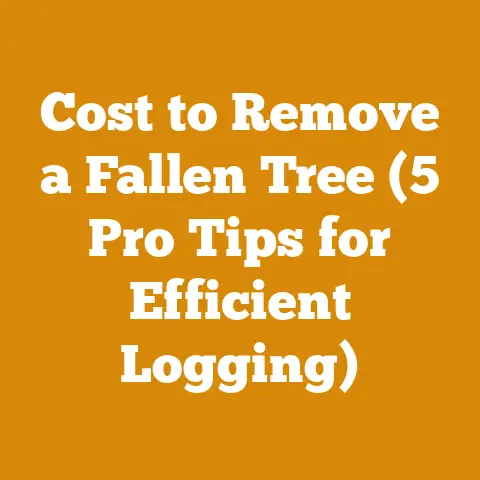Burnt Hardwood Flooring Waste: Efficient Disposal Tips (Pro Woodcare)
Ever been knee-deep in construction debris, staring at a mountain of burnt hardwood flooring scraps, and thought, “There has to be a better way than just chucking this in a landfill?” I have. Many times. As someone who’s spent a considerable chunk of my life around wood, from felling trees in the crisp autumn air to carefully crafting furniture in my small workshop, I understand the inherent value in every piece of timber. Even the burnt, seemingly useless bits. So, when faced with disposing of burnt hardwood flooring waste, I knew there had to be a more efficient, and frankly, more responsible way. This guide is born from that conviction.
Globally, the construction and demolition industry generates staggering amounts of waste. According to the EPA, in 2018 alone, construction and demolition debris accounted for 600 million tons in the United States, a significant portion of which is wood. Finding sustainable ways to manage this waste is not just good practice; it’s becoming increasingly crucial. In Europe, regulations like the Waste Framework Directive push for increased recycling and recovery rates in the construction sector, influencing how we handle even the most seemingly unusable materials.
This isn’t just about being eco-friendly; it’s about resourcefulness. It’s about transforming a disposal headache into a potential opportunity. From my experience, even burnt wood can have surprising uses, and responsible disposal methods can benefit both your wallet and the environment. Let’s dive into the world of efficient burnt hardwood flooring waste disposal, armed with practical tips, data-backed insights, and a healthy dose of wood-loving enthusiasm.
Understanding the Beast: Burnt Hardwood Flooring Waste
What Exactly Are We Dealing With?
Burnt hardwood flooring waste isn’t just any old wood scrap. It’s hardwood that has been subjected to fire, whether accidentally (house fire) or intentionally (controlled burn gone wrong). This means its properties have been altered, and that affects how we can handle it.
- Composition: Typically, this waste consists of planks or pieces of oak, maple, cherry, or other hardwoods used in flooring.
- Contamination: The burning process can introduce contaminants like soot, ash, and potentially harmful chemicals released from adhesives or finishes.
- Structural Integrity: Fire weakens the wood, making it more brittle and less structurally sound.
Why Can’t We Just Toss It?
Simply throwing burnt hardwood into a dumpster destined for a landfill has several downsides:
- Environmental Impact: Landfills are already overflowing. Decomposing wood releases methane, a potent greenhouse gas.
- Potential Hazards: Contaminants in burnt wood can leach into the soil and groundwater.
- Wasted Potential: Even burnt wood can sometimes be repurposed or recycled, reducing the need for virgin resources.
Key Considerations Before Disposal
Before you even think about disposal, consider these crucial factors:
- Safety First: Always wear appropriate personal protective equipment (PPE), including gloves, a dust mask, and eye protection when handling burnt wood. Soot and ash can be irritating to the skin and respiratory system.
- Contamination Assessment: If the fire involved chemicals, paints, or other hazardous materials, the wood may be contaminated. Consult with a hazardous waste disposal specialist.
- Quantity: The amount of waste will significantly impact your disposal options. A small pile from a DIY project is different than the aftermath of a house fire.
Options for Efficient Disposal: From Reclaiming to Recycling
Now, let’s explore the various ways to deal with your burnt hardwood flooring waste, starting with the most eco-friendly options and working our way down.
1. Reclaiming and Repurposing: Giving Burnt Wood a Second Life
This is my favorite option, as it aligns with the “waste not, want not” philosophy I learned from my grandfather, a master carpenter. Reclaiming burnt wood requires creativity and effort, but the results can be stunning.
- The Aesthetic Appeal of Charred Wood: Charred wood has a unique, rustic aesthetic that’s increasingly popular in design. The Japanese technique of “Shou Sugi Ban,” or Yakisugi, involves intentionally charring wood to preserve it and create a beautiful, textured surface.
-
Potential Projects:
- Feature Walls: Use charred planks to create a striking feature wall in your home or workshop.
- Garden Beds: Burnt wood can be used to construct raised garden beds, although be mindful of potential leaching of chemicals into the soil, especially if the wood was treated. Line the inside with plastic sheeting as a precaution.
- Rustic Furniture: Small pieces can be incorporated into furniture projects, adding a touch of history and character. I once built a small side table using reclaimed burnt wood as an accent, and it became a real conversation starter.
- Artistic Pieces: Burnt wood can be used for sculptures, wall art, or other decorative items.
-
Preparation:
- Cleaning: Thoroughly clean the wood with a stiff brush and water to remove loose soot and ash.
- Sealing: Apply a sealant to prevent further charring and to protect the wood from moisture.
- Safety: Always wear appropriate PPE during the cleaning and sealing process.
2. Recycling: Giving Waste a New Form
Recycling burnt hardwood is possible, but it depends on the extent of the damage and the availability of recycling facilities in your area.
- Wood Recycling Facilities: Some facilities specialize in recycling wood waste, grinding it into mulch, wood chips, or fuel.
- Finding a Facility: Search online for “wood recycling near me” or contact your local waste management authority for information.
- Requirements: Recycling facilities may have specific requirements for accepting burnt wood, such as removing nails, screws, or other hardware.
- Benefits: Recycling reduces landfill waste, conserves natural resources, and can even create new products.
3. Burning for Heat (with Caution)
Burning burnt hardwood for heat is a viable option, but it comes with significant caveats.
- Is it Safe? Burning wood that has been treated with chemicals or paints can release harmful toxins into the air. Do not burn treated or painted wood indoors. Even burning untreated burnt wood releases more smoke than seasoned firewood.
- Outdoor Use Only: If you choose to burn burnt hardwood, do so only in an outdoor fire pit or wood-burning stove designed for outdoor use.
- Seasoning: Burnt wood will likely be drier than green wood, but it may still contain some moisture. Allow it to air dry for several weeks before burning.
- Air Quality Regulations: Be aware of local air quality regulations regarding wood burning. Many areas have restrictions on burning wood during certain times of the year or on certain days.
- Alternative to Firewood: Burnt wood is generally not ideal for firewood. The charring process reduces its energy content, and it tends to burn quickly and produce a lot of ash.
- Personal Experience: I once tried burning some burnt pine scraps in my outdoor fire pit. The smoke was significantly more acrid and irritating than burning seasoned oak. I quickly learned my lesson and now only burn clean, seasoned firewood.
4. Composting: Returning Wood to the Earth
Composting burnt hardwood is a slow but effective way to break it down and return it to the soil.
- Ideal for Small Quantities: Composting is best suited for small amounts of burnt wood waste. Large pieces will take a very long time to decompose.
- Shredding or Chipping: To speed up the composting process, shred or chip the wood into smaller pieces. A wood chipper is ideal for this task, but you can also use a hatchet or axe for smaller pieces.
- Mixing with Other Materials: Mix the wood chips with other composting materials, such as leaves, grass clippings, and food scraps. This will provide the necessary nutrients and moisture for decomposition.
- Patience is Key: Composting wood takes time. It may take several months or even a year for the wood to fully decompose.
- Benefits: Composting reduces landfill waste, creates nutrient-rich soil, and reduces the need for chemical fertilizers.
5. Landfill Disposal: The Last Resort
If none of the above options are feasible, landfill disposal may be your only choice.
- Check Local Regulations: Some landfills may have specific requirements for accepting burnt wood waste. Contact your local waste management authority for information.
- Minimizing Impact: To minimize the environmental impact of landfill disposal, consider these steps:
- Reduce Volume: Break down the wood into smaller pieces to reduce its volume.
- Separate Materials: Remove any nails, screws, or other hardware.
- Proper Packaging: Dispose of the wood in sturdy bags or containers to prevent it from spreading in the landfill.
Step-by-Step Guide: Preparing Burnt Wood for Disposal
Regardless of which disposal method you choose, proper preparation is essential. Here’s a step-by-step guide:
- Safety Gear: Always wear appropriate PPE, including gloves, a dust mask, and eye protection.
- Sorting: Sort the wood waste into different categories based on its size, condition, and potential contaminants.
- Cleaning: Remove loose soot and ash with a stiff brush and water.
- Hardware Removal: Remove any nails, screws, or other hardware.
- Cutting or Shredding: Cut or shred the wood into smaller pieces to reduce its volume and prepare it for recycling or composting.
- Packaging: Package the wood waste in sturdy bags or containers for transportation.
- Transportation: Transport the wood waste to the appropriate disposal facility.
Tool Selection: Chainsaws, Axes, and More
Depending on the scale of your project and the disposal method you choose, you’ll need the right tools for the job.
- Chainsaws: Ideal for cutting large pieces of wood into smaller, more manageable sizes.
- Electric vs. Gas: Electric chainsaws are quieter and easier to maintain, but gas-powered chainsaws offer more power and portability.
- Safety Features: Always choose a chainsaw with safety features like a chain brake and anti-vibration system.
- Maintenance: Keep your chainsaw properly maintained by sharpening the chain regularly and lubricating the bar and chain.
- Axes and Hatchets: Useful for splitting smaller pieces of wood or for removing bark.
- Types of Axes: Splitting axes are designed for splitting wood along the grain, while felling axes are designed for cutting across the grain.
- Safety: Always use an axe on a stable surface and wear appropriate PPE, including eye protection.
- Wood Chippers: Ideal for shredding wood waste into small chips for composting or recycling.
- Electric vs. Gas: Electric wood chippers are quieter and easier to maintain, but gas-powered wood chippers offer more power and capacity.
- Safety Features: Always choose a wood chipper with safety features like a feed chute and overload protection.
- Hand Tools: A variety of hand tools, such as saws, hammers, and screwdrivers, can be useful for removing hardware and preparing wood for disposal.
Data Point: According to a study by the University of California, using a wood chipper can reduce the volume of wood waste by up to 75%, making it easier to transport and dispose of.
Cost and Budgeting Considerations
Disposing of burnt hardwood flooring waste can involve various costs, depending on the disposal method you choose.
- Landfill Disposal Fees: Landfills typically charge a fee per ton or cubic yard of waste.
- Recycling Fees: Recycling facilities may charge a fee for accepting wood waste.
- Equipment Rental: Renting a wood chipper or other equipment can add to the cost.
- Transportation Costs: Transporting the wood waste to a disposal facility can involve fuel costs or transportation fees.
- Labor Costs: If you hire someone to help you with the disposal process, you’ll need to factor in labor costs.
Budgeting Tips:
- Get Quotes: Obtain quotes from multiple disposal facilities to compare prices.
- Consider DIY: If possible, handle the disposal process yourself to save on labor costs.
- Rent Equipment: Renting equipment can be more cost-effective than buying it, especially if you only need it for a one-time project.
- Explore Free Options: Look for free disposal options, such as community composting programs or wood recycling events.
Troubleshooting and Common Pitfalls
Disposing of burnt hardwood flooring waste can be challenging, and it’s important to be aware of potential pitfalls.
- Contamination: If the wood is contaminated with hazardous materials, you’ll need to consult with a hazardous waste disposal specialist.
- Large Quantities: Disposing of large quantities of wood waste can be time-consuming and expensive.
- Limited Access: If you have limited access to disposal facilities, you may need to transport the wood waste a long distance.
- Weather Conditions: Inclement weather can make it difficult to handle and transport wood waste.
- Unexpected Costs: Be prepared for unexpected costs, such as equipment repairs or disposal fees.
Troubleshooting Tips:
- Plan Ahead: Develop a detailed disposal plan before you start the project.
- Seek Advice: Consult with experts, such as waste management professionals or wood recycling specialists.
- Be Flexible: Be prepared to adjust your disposal plan if necessary.
- Stay Safe: Always prioritize safety when handling and disposing of wood waste.
Case Study: From Fire Damage to Feature Wall
I recall a project a few years back where a friend’s workshop suffered minor fire damage. Most of the wood was salvageable, but a significant amount of hardwood flooring was charred beyond its original use. Instead of sending it all to the landfill, we decided to get creative.
The Challenge: The flooring was a mix of oak and maple, some planks more damaged than others. There were also concerns about lingering smoke odor.
The Solution:
- Assessment: We carefully assessed each plank, separating the heavily damaged pieces from those with only surface charring.
- Cleaning: Using wire brushes and a mild detergent, we thoroughly cleaned the salvageable planks.
- Shou Sugi Ban Inspired Treatment: For some planks, we intentionally deepened the charring using a torch, mimicking the Shou Sugi Ban technique. This not only enhanced the aesthetic but also helped to seal the wood.
- Sealing: We applied several coats of a matte sealant to protect the wood and minimize any lingering odor.
- Feature Wall Creation: The planks were then used to create a stunning feature wall in his new workshop space.
The Result: The project was a resounding success. The feature wall added a unique and rustic touch to the workshop, and we diverted a significant amount of waste from the landfill. The total cost was minimal, primarily involving the cost of the sealant and some elbow grease.
Key Takeaway: This project demonstrated the potential for transforming burnt wood waste into a valuable and aesthetically pleasing resource.
Next Steps and Additional Resources
You’ve made it through the guide! Now it’s time to put this knowledge into action. Here are some next steps and additional resources to help you on your way:
- Assess Your Waste: Evaluate the quantity and condition of your burnt hardwood flooring waste.
- Choose a Disposal Method: Select the disposal method that best suits your needs and resources.
- Gather Your Tools: Assemble the necessary tools and equipment.
- Prepare the Wood: Follow the step-by-step guide to prepare the wood for disposal.
- Dispose of the Waste: Transport the wood waste to the appropriate disposal facility.
Additional Resources:
- Local Waste Management Authority: Contact your local waste management authority for information on recycling and disposal options.
- Wood Recycling Facilities: Search online for “wood recycling near me” to find local facilities.
- Equipment Rental Companies: Rent equipment like wood chippers and chainsaws from local rental companies.
- Hazardous Waste Disposal Specialists: Consult with a hazardous waste disposal specialist if you suspect the wood is contaminated.
- Online Forums and Communities: Connect with other woodworkers and DIY enthusiasts online for tips and advice.
- Suppliers of Logging Tools and Drying Equipment:
- Bailey’s: A leading supplier of logging tools and equipment.
- Northern Tool + Equipment: Offers a wide range of tools and equipment for wood processing and firewood preparation.
- Local Hardware Stores: Your local hardware store can provide a variety of tools and supplies for your project.
Final Thoughts: Turning Waste into Opportunity
Disposing of burnt hardwood flooring waste doesn’t have to be a burden. By understanding the options available, preparing the wood properly, and utilizing the right tools, you can turn a disposal headache into an opportunity to be resourceful, environmentally responsible, and perhaps even a little creative. From reclaiming and repurposing to recycling and composting, there are many ways to give burnt wood a second life or return it to the earth. So, the next time you’re faced with a pile of burnt wood, remember that it’s not just waste; it’s a resource waiting to be unlocked. Good luck, and happy woodworking!






